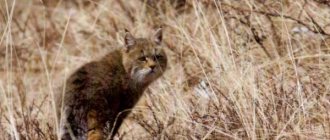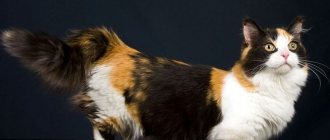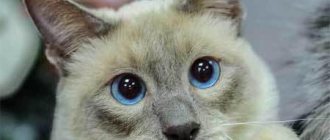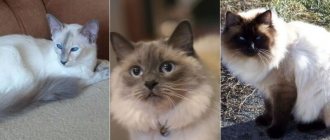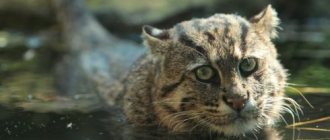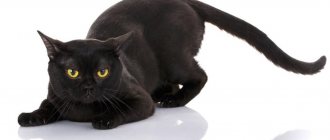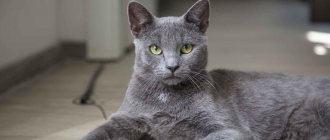The Ragamuffin cat breed is considered relatively new, but in a short amount of time it has managed to firmly establish itself in the hearts of pet lovers. If you delve into the history of its breeding, you can highlight several interesting facts.
By crossing the Ragdoll breed with other breeds of yard and purebred cats, the result was Ragamuffin cats, with a variety of colors and soft fur coats. The fur of this breed is semi-long, the number of varieties is such that the eyes run wild.
The soft wool resembles rabbit fur. Such features of cats' fur are very attractive to the owner; it is impossible to resist caressing such a soft pet.
History of creation
The ancestor of the Ragamuffin breed was the breed of popular American cats - Redgalls. What is a ragamuffin? The translation of the unusual name is ragamuffin, which refers to the unusual appearance of cats - “rag doll” or “ragamuffin”.
The prerequisite for the appearance of the breed was a scandal between the American breeder Anne Baker and a group of felinologists who did not share the rights to breed Ragdoll cats. The essence of the problem was that Mrs. Baker, who declared herself to be the creator of a new breed, went too far with total control. Having managed to be the first to register the rights to the “Ragdoll” trademark, the woman set a bunch of restrictions for other breeders. The cat breed was created by Ann Baker back in the 60s of the last century.
However, in the 70s of the twentieth century, Ann Baker decided to break her ban and created a new breed. In order to improve genes, health, character and diversify the color, they began to breed the Ragdoll with Persian, Hemalayan and yard long-haired cats. The ancestor of the Ragamuffin breed is considered to be the cat Josephine, who did not have any known origin. Most likely, the cat had a mixture of Persian and Angora roots.
Handsome Ragamuffin
At first the new breed was called “cherub”. Many believe that it was more suitable for these beautiful and friendly cats. But then they renamed it “ragamuffin”, which translates as “ragamuffin” - due to the predominance of the blood of barn cats.
Ragamuffins have not gained the same popularity as Redgalls. This was influenced by the status of the Red Goll breed and the famous name of their breeder. Nevertheless, they still found their audience, since they had undoubted advantages over many other cat breeds.
The Ragamuffin cat was not recognized by official felinological organizations for a long time. These animals were initially registered with the American association UFO (United Feline Organization). Only in 2011, the breed was recognized in the more famous CFA (Cat Fanciers' Association) in Russia, which allowed the new pet to receive champion status. Today, this animal is also registered in the international systems AGFA, WCF, GCCF.
How the breed appeared
For those who are only indirectly familiar with the English language, the name of the breed may seem, at first glance, rather “sweet”. The well-known word “muffin” catches your eye, and images of fragrant buns or cupcakes with raisins immediately appear in your head. However, in reality everything is not so simple. After all, among the English, a ragamuffin is a ragamuffin and a tramp. For fluffy and charming purrs, this name seems unexpected. However, after studying the history of the origin of the breed, everything falls into place.
It all started with the fact that in 1963, Persian cat breeder Ann Baker, living in the town of Riverside (USA), drew attention to a flock of yard cats. They were regularly fed by a neighboring family. Among these purrs was Josephine, who gave birth to beautiful long-haired kittens with an affectionate character in each litter. And although the fathers of each group of animals were different, according to Ann Baker, the cats inherited their friendly disposition from their mother. This circumstance was connected with the fact that the cat was rescued and people were coming out after a car accident. The breeder decided to consolidate such interesting features and develop a new breed from the street cats born to Josephine.
It was decided to name the new breed Cherub, which means “Highest angelic rank” in the Christian religion. However, Mrs. Baker set very strict demands for the clubs:
- only the founder herself could choose representatives for breeding the breed;
- decisions regarding matings also remained with the breeder.
Such control was not to the liking of many who wanted to breed the breed. And in 1967, a group of breeders decided to independently develop “cherubs”. To emphasize independence from Ann Baker, the name was changed to "Ragdoll". The main focus was obtaining additional types of animal coat colors. However, the breeder did not ignore this process. And, having changed the original name “Cherub”, she patented “Ragdoll” as the official one. From then on, kittens could only be used under Mrs. Baker's breeding program.
Ragdoll - the founder of the Ragamuffin breed
20 years later, having gone through numerous courts and disputes with breeders, the founder of the breed decided to leave breeding work. In 1993, the International Ragdoll Cat Association almost succeeded in taking control of the breeding of these fluffy purrs into its own hands. However, at the last moment Mrs. Baker changed her mind. And she began to breed another breed, crossing ragdolls with outbred long-haired cats. As a result, a large female was born, distinguished by its beautiful colors and unlike other “cherubs”.
This state of affairs was not to the liking of the breeders. Because of this, since 1994, some breeders have continued to develop the Ragdoll breed. And other breeders focused on distributing new “cherubs,” which were given the name “Ragamuffin” in honor of their outbred street ancestors.
Thanks to the mixture of various cat bloods - Persian, Himalayan, Siamese, outbred yard - Ragamuffins have expanded the color palette of colors. Other characteristics of the breed have also changed - the size of the body has become larger, and the iris of the eyes has become brighter and more colorful.
Breed appearance standard
These are large animals: the weight of males reaches 10 kg, females - 8 kg. In appearance they resemble a lion. The peculiarity of such pets is their well-fed body. In particular, the standard characterizes them as heavy, bony pets with an emphatically tender look and rabbit fur. Another feature of ragamuffins is the increased amount of fat in the abdominal area, which gives the purr’s body a pleasant softness and roundness.
Anatomical features: description
- Body: Proportionally rectangular with a wide chest, powerful shoulders and pelvis. A layer of fat often forms in the lower abdomen, but it should not significantly affect body weight. Reproductive age occurs after 4 years.
- Head: Wedge-shaped with rounded outlines, without obvious angularities. The chin and forehead are smoothed, the face is small, slightly expanded due to fluffy cheeks and plump mustache pads.
- Eyes: expressive, large, set wide. Any color is allowed, but there is an exceptional requirement for animals with mink and sepia coat colors - for the former, sea green eye color is important, for the latter - green or yellow.
- Ears: neat, triangular, slightly tilted forward, with a flattened tip ending in a tassel, like a Maine Coon's.
- Paws: Medium length, with large pads, support heavy bones. The hind limbs are somewhat longer than the forelimbs.
- Tail: luxurious, fluffy, proportional to the body, slightly tapering towards the tip.
Photo: ragamuffins of different colors
Coat and color
It is worth saying that Ragamuffin fur is unique. It is very dense and very soft, and can be of different lengths. People who have petted Ragamuffins claim that the fur of these cats is like silk. The fur layer has two rows and a dense undercoat, which is not inferior in length and density to the guard hairs.
Ragamuffins have completely different colors. This breed largely split off from the Redgall due to the fact that kittens of other colors began to appear. Therefore, Ragamuffins do not have a standard color. However, in some associations the most revered color is white.
The nose and paw pads must match the color of the coat. Only white Ragamuffins can have pink, bicolor, or multicolor paw pads. The eyes of Ragamuffins are necessarily bright, but also have no standards for color.
The most common colors of ragamuffins are as follows:
- Color point. This is a Siamese color with prominent points - points, on protruding parts of the body. The muzzle, ears, tips of the paws and tail are colored darker. In ragamuffins, this color can have different variations: brown, black, chocolate, reddish. The main thing is that the color of the body is lighter than the color of the points;
- Black ragamuffins are also common, but exclusively black ones without markings are extremely rare. Most often they have parts of the body painted white: chest, paws, muzzle or tail. Such ragamuffins are prized at exhibitions because they look very impressive;
- Tabby. A color in which very bright dark stripes or spots stand out against a main white background.
White Ragamuffin
Diseases and health problems
The rich experience of crossing throughout the history of the breed has awarded Ragamuffins with excellent health and excellent immunity. These cats rarely get sick and rarely catch a cold, so you can safely walk down the street with them.
There are a number of hereditary diseases that can only be detected using a DNA test. Before crossing two individuals, testing should be carried out to show whether the offspring are at risk of developing these diseases. This disease is hypertrophic cardiomyopathy and hereditary polycystic kidney disease. Animals with these diseases do not live long.
Instead of having health problems, Ragamuffins have developed characteristics that set them apart from other cats. For example, loneliness can cause cats to become depressed, which can lead to other health problems.
Depressed cats are inactive, lose weight, and do not want to eat at all. Such cats are treated with antidepressants, but it is very difficult to treat Ragamuffin depression. When getting a Ragamuffin, you need to leave at least one more small pet with him, who will communicate with the cat.
Ragamuffins are very stressed. Fear can be fatal for Ragamuffins - they can permanently acquire a phobia and begin to flinch at any moment that reminds him of fear. A stressed animal may either eat a lot or refuse to eat, and the Ragamuffin will need even more presence from its owner.
Character and habits
It's hard to find a friendlier cat than the Ragamuffin. The animal is completely devoid of aggression and allows a person to do any action - stroking, carrying, squeezing, other pleasantries, without absolutely objecting and without releasing its claws.
Ragamuffins are endlessly devoted to the family in which they have lived since childhood. Therefore, it is not worth giving an adult cat to other people; he will never take root in someone else’s environment and will always miss his owners.
Ragamuffins are quite sociable cats. They get along well with other cats who are ready to make contact, but if aggression is shown towards them, the Ragamuffin will never take the initiative to get acquainted. Thanks to such a loyal character, these cats get along well with children and are even willing to tolerate playing with them.
A real purebred ragamuffin is an incredibly kind and affectionate creature, whose favorite pastime is to perch on the owner’s arms and hang from them with a limp carcass, simulating an accidental fainting.
The Ragamuffin is an affectionate and kind breed.
In general, the breed can be called decorative: these well-fed cats really value the comfort of home and get lost in outdoor conditions, often becoming confused
By the way, despite the fact that Ragamuffins have never been considered hyperactive pets, they are not considered complete lazy people either. If the fluffy doesn’t have his favorite toy or something similar in his field of vision, he’ll come up with another form of entertainment. For example, he will begin to rush around the apartment, fleeing from an imaginary enemy, or will enter into a duel with the curtains.
Tips for choosing a kitten
The final color of “cherubs” is formed only by 4 months, so it is not advisable to get acquainted with kittens before this period. First of all, you need to check the documents of the nursery. He must be licensed by ACFA and CFA. It is equally important to evaluate the living conditions of the animals. If there is a lot of dirt around, contact another breeder.
When meeting a kitten directly, use the following recommendations:
- Make sure there are no signs indicating the presence of illness. Watery eyes, unpleasant odor from the fur or from the mouth, constant scabies, dirt under the tail and other alarming symptoms require mandatory isolation. It is not prohibited to get sick in the nursery, but to avoid infection, sick animals must be kept in a separate room.
- Study the length of the tail. Most kittens have a short length, but not cherubs. The impressive length of the tail relative to the body is observed already in early childhood and is clearly visible visually.
- Check the brightness and saturation of the iris. The higher they are, the better. It is also possible for the eyes to remain blue for up to 2 months, but most often the color changes within 5 weeks after birth.
- Try to communicate. A purebred kitten should not show cowardice or aggression. Curiosity and slight timidity are encouraged.
- Take the baby in your arms. The right Ragamuffin will immediately melt into a hug and hang like a rag doll, just like a Ragdoll. Remember that a purebred kitten should not struggle or show other signs of excessive activity.
Feel free to ask to meet the babies' parents and also check their breeding documents. Thanks to this, you will be able to evaluate the appearance of animals, the adequacy of their behavior, pedigree and the presence of diseases confirmed by a doctor.
Education and training
Ragamuffins are smart. They are easy to train and have no difficulties in raising them. But there is an important nuance: the Ragamuffin should be the first animal you bring into your apartment. He should not feel competition from other animals, all attention should be focused only on him.
You can easily arouse his interest in simple acrobatic tricks, and also develop the habit of responding to his nickname. There are no difficulties with using the tray either. These are not those stubborn people who need to be explained for a month how to use the toilet, and who will try, out of harm, to leave odorous puddles where they prefer.
Ragamuffin is easy to train
Immediately stop your baby from engaging in annoying pranks like scratching the wallpaper, digging in the trash can, and swinging on the curtains. Yes, such antics look funny when performed by a tiny hooligan, but imagine what the house will turn into when four years later an eight-kilogram carcass performs the same tricks.
If the cunning lawless man begins to climb onto the shelves of the closet or the kitchen table, remove him from the improvised observation platforms, simultaneously making a suggestion in a stern tone (do not shout). Please note that the mustachioed fat man jumps and lands extremely awkwardly, which leads to injuries. Obedience is most effectively taught using standard prohibitory commands (“No!”). If you regularly use a short, sharp ban, the animal will have no choice but to learn to listen. An alternative to classical methods can be a clicker, which Western experts love to use.
Cats of this breed are easy to train
Features of mating and breeding
The breed remains one of the rarest, and there are still no nurseries breeding Ragamuffins in post-Soviet territory. Breeders who specialize in ragdolls are showing interest in this breed. Breeding work with the new breed is hampered by two main factors: firstly, there is no sufficient gene pool, and secondly, there is no demand for the cute, but very expensive kittens of this little-known Ragamuffin.
The population of ragamuffins is limited, and choosing a parent pair is a considerable problem
Ragamuffins are recommended to be bred no earlier than three years of age, although even by this age the formation of animals is not yet completely completed. Cats of this breed are unusually delicate even in matters of love - they can care for a cat platonically for a very long time before daring to take more decisive actions. There are no other reproductive problems in the breed: matings are usually successful, cats tolerate pregnancy well and give birth easily.
Newborn Ragamuffin kittens are always white
Litters are often multiple and delight the eye with a variety of colors. Ragamuffin kittens are born completely white, the color spots begin to appear gradually, from the first days of life to six months. Babies develop more slowly than in other breeds.
One litter can have kittens of different colors
Only adult, absolutely healthy animals, vaccinated and treated for parasites, are allowed for breeding, which must be marked accordingly in the veterinary passport. Both producers must have certificates of breed conformity entered in the register of the felinological organization where these animals are registered. Interbreed matings are not allowed. The optimal age for castration or sterilization is about a year.
Sterilizing a cat is a abdominal operation that requires serious rehabilitation.
Care and maintenance of the breed
The Ragamuffin breed is a very clean breed. Animals themselves devote a lot of time to caring for their appearance. Pet owners only need to perform those hygiene procedures that a cat cannot do.
Wool
You don’t have to be afraid of tangles: the structure of their fur is similar to that of a rabbit’s and practically does not mat. But you still need to comb your cat: once a week (during shedding - 2 times) with a special comb with long metal teeth. During the molting period - autumn and spring - more often.
Bathing
Ragamuffins don’t particularly like water, but they will be quite indignant during bathing. Bathe them at least once a year, or better yet, once every six months. Plug your ears with cotton swabs, comb your fur coat, and make sure that moisture does not get into your ears. Use only special shampoos for cats.
Claws
Nails - trim once every 1-2 weeks with nail clippers or manicure scissors, and then file. However, a scratching post is also necessary.
A scratching post is necessary for ragamuffins
Teeth
Teeth should be brushed 2 times a month. You cannot use human brushes and toothpaste: fluoride is harmful to the cat’s body, and hard bristles will scratch delicate gums.
Animals should be taught to brush from an early age. First use a cotton swab soaked in tooth gel, then buy a brush. You can wrap your finger in gauze, but only if the cat does not bite it.
Care, hygiene, nutrition
The Ragamuffin's coat is relatively long and requires special care. But these procedures are not burdensome, so the hair does not roll off. It is enough to comb your pet once a week and occasionally wash it with special pet shampoos. The cat does not like bathing too much, but will never interfere with water procedures due to its flexible nature.
You should also monitor the condition of the animal’s eyes, nasal passages, and ears and, if necessary, wipe them with cotton pads using special lotions.
The “ragamuffin” is distinguished by good health and does not cause concern to the owner with his illnesses. One should not forget only about timely deworming and vaccination.
This large cat is prone to obesity. Therefore, you need to choose the right and complete diet, and prevent your pet from overeating and eating foods from the human table. Premium or super-premium food is best suited. To avoid the formation of hairballs in the stomach, you should include a special paste in your diet.
Rare cases of cardiomyopathy and hip dysplasia have been reported. To prevent diseases, you should carefully monitor your pet’s health and consult a veterinarian in a timely manner.
A calm and good-natured disposition and high intelligence make this cat easy to train. It is necessary to introduce your pet to a scratching post and litter tray in a timely manner. And then there will be no problems in its maintenance.
Feeding
Ragamuffins love to eat. Therefore, the owner will have to strictly control the portions given out and not allow the pet to overeat.
There are two feeding options: special ready-made food or hand-cooked food. Each has both pros and cons.
For a cat to be healthy, it needs a balanced diet.
From natural products, cats of this breed can be given:
- Meat: beef, veal, rabbit, turkey (at least 30 grams for a kitten and 120 grams for an adult). There is no need to boil it, just pour boiling water over it. Give 3-4 times a week.
- Boiled liver, hearts, ventricles, minced chicken necks. Liver - no more than once a week. The rest - 2-3 times.
- Fish – only sea fish, no more than once a week. It is allowed to feed the cat shrimp and squid from time to time.
- Fermented milk products (ryazhenka, natural yogurt, cream, kefir, sour cream, cottage cheese, cheese): low-fat, without harmful additives and dyes. Can be given every day.
- Liquid porridges: liquid, oatmeal, semolina, buckwheat, millet. Not with milk, but with water. Be sure to add a few drops of vegetable oil to the prepared food.
- Eggs (chicken and quail) – a couple of times a week. From chicken - only the yolk and boiled.
- Boiled or stewed vegetables: cauliflower, carrots, green beans. Give 1-5 times a week, adding to porridge. Sprouted oats, wheat, barley, and young nettle leaves are useful.
It is prohibited to give:
- Goose, duck, pork and lamb meat;
- Bones, fat, skin;
- Whole cow's milk;
- Salt, sugar, spices, seasonings, mayonnaise, sauces;
- Sweet, smoked, baked goods, flour, salty, fried;
- Canned food, sausages, frankfurters, small sausages;
- Peas, soybeans, beans, potatoes, grapes, avocados, bananas;
- Vitamins and supplements for people.
Castration and sterilization
Doctors recommend carrying out such operations before the cat reaches reproductive age. That is, when they are between six and twelve months old.
After the operation, the ragamuffin will be restored within 24 hours, so that the recovery goes well, you can use these requirements:
- Treating the wound with terramycin ointment or other ointment prescribed by a doctor;
- Eliminate the possibility of the ragamuffin being at a great distance from the floor to avoid falls;
- Feeding for cats during the first twelve hours after leaving the operating room occurs in small portions, for cats - the first twenty-four hours;
- If stool retention occurs for more than two days, then you should give your pet Vaseline oil;
- Supplying cats with a special blanket to prevent seams from coming apart during the first two weeks;
- After two or three weeks you need to be examined by a doctor.
Diseases and defects of the breed
The immunity of cats is quite strong, because in their pedigree there were outbred street individuals. They made the breed stronger and more resistant to infections. So far, no disease associated with genetics has been identified.
Ragamuffins can get sick:
- allergies;
- cardiomyopathy;
- gastrointestinal disorders;
- polycystic kidney disease;
- periodontal disease;
- obesity.
Most of these predispositions can be corrected through proper and balanced nutrition and regular teeth brushing. Attention should be paid to vitamin complexes and supplements, as well as anti-parasitic prevention.
Timely vaccination of the animal will help to avoid a large number of problems in the future, especially with regard to viral diseases. If you take proper care of your ragamuffin and feed it correctly, it will be a loyal friend for quite a long time - up to 16 years.
It is necessary to take your pet to the veterinarian
Ragamuffin breeding
Females and male cats that have reached the age of three years are allowed to breed. Animals must be absolutely healthy, including those without internal parasites. All vaccinations must be included in the animal's passport. Male and female cats are listed as the same breed because interbreed matings are not allowed for Ragamuffins.
Due to their nature, Ragamuffins are not aggressive and are sociable. Cats, even sensing the cat's heat, behave very courteously and even shyly, so the animals may need a lot of time to get to know and get used to each other. Therefore, the Ragamuffin cat will have to be brought to visit the cat several times until the animals communicate.
Description of the Ragamuffin breed
The Ragamuffin cat is medium or large in size, weighs about 5-8 kg, has a strong skeleton and well-fed body, and is distinguished by large expressive eyes. Males are somewhat larger; 10 kilograms is not the limit for their weight.
Prolonged solitude is unacceptable for a pet because it can cause stress. Such emotional trauma will lead to difficulties in further contact, as the Ragamuffin will feel lonely and abandoned. Cats of other breeds do not have such qualities; they are usually left to their own devices and enjoy it.
How to choose a kitten
First of all, you need to pay attention to the eye color of the little Ragamuffin. The richer and brighter the shade of the iris, the better. Purebred kittens have a strong rectangular chest, a long tail and powerful hind legs. The pet must be active, playful, and not afraid of people. You should be wary if he is timid and does not make contact. The nose and eyes should be free of discharge, dry and clean.
Characteristics of Ragamuffin cats
The most important characteristic feature of the Ragamuffin cat is its exceptional flexibility. The genes of yard cats combined with the genes of purebred ragdolls have given the world amazingly affectionate and sociable cats. This pet will happily spend a lot of time on the laps of its owners and fill the living space around it with loud, gentle purring.
The gentle nature allows Ragamuffin cats to adapt to any living conditions; the calm animal is absolutely undemanding. But at the same time, the cat is very attached to its owners, and tries to spend all its time close to them. Such a pet will not miss the care and return of its owners. She will definitely be at the exit in order to see her off and then meet her owners with a friendly purr and a kind, attentive look. The cat will not approve of the long absence of her patrons, since she needs communication.
Calmness and restraint will also manifest themselves in close communication with children. The owner's pet is able to withstand the desire of little ones to cuddle such a fluffy animal. But we must keep in mind that these pets absolutely do not know how to protect themselves, because crossing has completely eradicated hunting instincts in them, and if there is aggression from any side, they will prefer to hide in the farthest corner of the room. Such a beauty will also not hunt down mice if they are present in the house, all for the same reason that there is no need for hunting at the genetic level.
A good level of intelligence makes it possible to train a furry pet, since intelligence and perseverance are integral character qualities.
There are no hunting instincts, therefore the coexistence of other non-aggressive animals in the same apartment is acceptable. The Ragamuffin cat nevertheless loves to play and will not refuse the opportunity to spend time actively and climb somewhere higher. Ragamuffin kittens are curious from childhood and will gradually explore all available places in the living space, and then curiosity will push them to explore hard-to-reach places.
Pros and cons of ragamuffins
| + | – |
| Calm temperament, peacefulness. | Ragamuffins are vulnerable and unable to stand up for themselves. |
| Ragamuffins are not noisy animals at all. | Ragamuffins are very afraid of water; |
| Ragamuffins are well trained and quickly learn the rules of behavior in an apartment; | Ragamuffins are susceptible to stress. |
| Representatives of this breed trust their owners. | They shed heavily, especially during certain periods. |
Special needs
Ragamuffins are best kept in an apartment. They need a lot of attention and a lot of toys. They are affectionate in nature and not aggressive towards other cats. However, they are prone to gaining weight, which can lead to problems. For example, liver diseases. They require daily care.
Cats are more difficult to train than dogs, but it is doable with the right reinforcement. Kittens need to be trained to use the litter box from childhood. Cats are very clean, and this will not be difficult. But you must keep the tray clean, otherwise your Ragamuffin will not want to use it. It is necessary to carry out prevention against parasites and take care of the cat’s health throughout its life. Don't be afraid to contact your veterinarian, and you may also want to consider insurance.
How much does ragamuffin cost and where to buy it?
The main nurseries of the Ragamuffin breed are located in the United States. There are registered breeders in Canada, South Korea, England, the Netherlands, Bulgaria, Austria, but there are none in the former CIS countries. It is possible that Ragamuffin cats are bred by the owners of Ragdoll nurseries, of which there are many in Russia, including in Gomel and Kyiv. The availability of children and their cost must be determined individually.
Purebred Ragamuffin
Prices for the breed start at $850 or more. For a kitten with a good pedigree and high quality indicators you will have to pay from $1,500. From private owners you can find a kitten at a more affordable price ranging from $550-800.
How long do they live?
The life expectancy of representatives of the breed largely depends on the correct conditions of detention and whether the pet is neutered or not. On average, Ragdolls live from 11 to 15 years.
Not castrati
Non-castrated cats and non-sterilized cats, if they do not participate in breeding and cannot realize their natural instinct to reproduce, live 2-3 years less. This is due to frequent fluctuations in hormonal levels and the development of pathologies of the reproductive system, due to the inability of its proper functioning.


